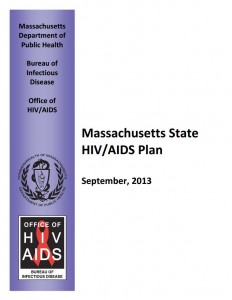Massachusetts HIV/AIDS Plan Aligns with National Strategy to End HIV/AIDS Epidemic
Topics
 In September 2013, the Massachusetts Department of Public Health’s (MDPH) Office of HIV/AIDS released its latest strategic plan intended to further the state’s long-standing success in combating the HIV epidemic in the Commonwealth. As explained in the plan, advances in HIV prevention, diagnostics and treatment, as well as greater integration of public health and health care systems afforded by the Patient Protection and Affordable Care Act (ACA), have prompted Massachusetts to articulate new recommendations to optimize the impact of its public health resources.
In September 2013, the Massachusetts Department of Public Health’s (MDPH) Office of HIV/AIDS released its latest strategic plan intended to further the state’s long-standing success in combating the HIV epidemic in the Commonwealth. As explained in the plan, advances in HIV prevention, diagnostics and treatment, as well as greater integration of public health and health care systems afforded by the Patient Protection and Affordable Care Act (ACA), have prompted Massachusetts to articulate new recommendations to optimize the impact of its public health resources.
The Massachusetts plan is noteworthy for several reasons. First, in addition to sharing the National HIV/AIDS Strategy’s goals of reducing new HIV infections, improving health outcomes, and reducing HIV-associated health disparities and inequities, the plan broadens its focus to incorporate hepatitis C virus (HCV) infection into its strategies to enhance statewide prevention, treatment, and care services. According to U.S. Department of Health and Human Services Deputy Assistant Secretary for Health, Ronald O. Valdiserri, MD, MPH,
“Viral hepatitis is one of the co-occurring conditions that must be addressed if we are to improve health outcomes for people living with HIV. Massachusetts has made an important advance by integrating viral hepatitis into its new HIV/AIDS plan.”
 Second, the plan uses local HIV surveillance data to maximize the impact of limited resources to address the prevention, treatment, and care needs of those most affected by HIV and HCV in Massachusetts – particularly men who have sex with men (MSM) of all races/ethnicities and injection drug users (IDU). In addition, the new plan seeks to use surveillance data to improve HIV care outcomes by minimizing attrition at each step along the continuum from timely HIV diagnosis to linkage and retention in HIV medical care, through receipt of antiretroviral treatment, and the eventual achievement of durable viral suppression. In this way, the plan aligns with the July 2013 White House HIV Care Continuum Initiative and the Center for Disease Control and Prevention’s emphasis on high-impact prevention, which refers to the use of effective, cost-effective, combination prevention strategies for the U.S. populations and areas most affected by the HIV epidemic.
Second, the plan uses local HIV surveillance data to maximize the impact of limited resources to address the prevention, treatment, and care needs of those most affected by HIV and HCV in Massachusetts – particularly men who have sex with men (MSM) of all races/ethnicities and injection drug users (IDU). In addition, the new plan seeks to use surveillance data to improve HIV care outcomes by minimizing attrition at each step along the continuum from timely HIV diagnosis to linkage and retention in HIV medical care, through receipt of antiretroviral treatment, and the eventual achievement of durable viral suppression. In this way, the plan aligns with the July 2013 White House HIV Care Continuum Initiative and the Center for Disease Control and Prevention’s emphasis on high-impact prevention, which refers to the use of effective, cost-effective, combination prevention strategies for the U.S. populations and areas most affected by the HIV epidemic.
A third way the Massachusetts HIV/AIDS Plan builds upon its past successes is the way in which it monitors outcomes. Specifically, the new plan articulates a number of carefully detailed objectives developed in collaboration with key stakeholders—objectives that identify specific areas for improvement, detail measurable indicators of progress, prescribe specific actions, describe realistic results in light of existing resources, and offer a time frame by which results are expected. The quantitative objectives described in the plan also strike an important balance between reflecting aspirational and practical goals. Moreover, this emphasis on quantitative outcomes positions Massachusetts to use health economic and other modeling tools to better inform resource allocation decision-making by state policy makers, advocates, and services implementers.
The Massachusetts plan embraces priorities detailed in the National HIV/AIDS Strategy, which encourages all states to develop comprehensive, locally-tailored HIV/AIDS plans that expand the use of targeted HIV prevention strategies and evidence-based interventions to enhance coordination between planning and resource allocation activities, map public and private resources within states, and address the range of HIV prevention, treatment, and care needs.
Finally, the new Massachusetts HIV/AIDS plan provides actionable recommendations in several key areas, such as strengthening programmatic responses, assembling the evidence-base for decision making, enhancing integration and continuity of services, leveraging revenue from third-party reimbursements, and assuring the sustainability of critical services. According to Dawn Fukuda, Sc.M., Director of the MDPH’s Office of HIV/AIDS,
“The Plan will maximize our success because it defines clear priorities in the context of the existing infrastructure and policy landscape, responds to the prevention and care needs of our most vulnerable residents, and enables us to adapt to an evolving health care system.”
Next steps in the state planning process will be the development of an implementation plan with key stakeholders; ongoing monitoring of successes and challenges, stakeholder input and other data that will help to inform future course corrections, as needed. Interested readers can access the plan here.